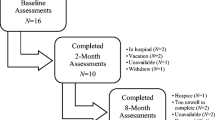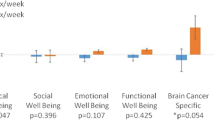Abstract
Goals of the work
The purpose of the present investigation was to examine the interest and exercise preferences of an institution-based sample of brain tumor patients. Secondary aims were to examine potential differences in participant’s interest and preferences by exercise behavior and select demographic/medical variables.
Materials and methods
Using a cross-sectional design, 106 brain tumor patients (age range, 32 to 83 years) who received treatment at the Preston Robert Tisch Brain Tumor Center (BTC) at Duke completed a questionnaire that assessed self-reported exercise behavior, exercise interest and preferences during active and off-treatment periods.
Main results
For exercise program preferences, participants were significantly more interested and felt more capable of participating in an exercise program following compared to during adjuvant therapy. Approximately equal proportions of brain tumor patients preferred to exercise at home with their spouse or other family members. These preferences were consistent across both cancer treatment-related time periods. For exercise information preferences, a higher proportion of respondents preferred receiving information via technologically based approaches (i.e., Internet, CD-ROM, and mailed correspondence) compared with more traditional methods (i.e., mail or face-to-face counseling). Chi-square analyses revealed that a small number of exercise program and information preferences were modified by exercise, medical, and demographic variables.
Conclusions
Brain tumor patients may have unique and varied preferences compared with other cancer populations. Incorporating patient’s preferences into rehabilitation programs and clinical exercise investigations may optimize the potential benefits of this modality for patients with neurologic malignancies.
Similar content being viewed by others
References
Galvao DA, Newton RU (2005) Review of exercise intervention studies in cancer patients. J Clin Oncol 23(4):899–909
Knols R, Aaronson NK, Uebelhart D, Fransen J, Aufdemkampe G (2005) Physical exercise in cancer patients during and after medical treatment: a systematic review of randomized and controlled clinical trials. J Clin Oncol 23(16):3830–3842
Courneya KS, Friedenreich CM, Sela RA, Quinney HA, Rhodes RE, Handman M (2003) The group psychotherapy and home-based physical exercise (group-hope) trial in cancer survivors: physical fitness and quality of life outcomes. Psychooncology 12(4):357–374
Courneya KS, Mackey JR, Bell GJ, Jones LW, Field CJ, Fairey AS (2003) Randomized controlled trial of exercise training in postmenopausal breast cancer survivors: cardiopulmonary and quality of life outcomes. J Clin Oncol 21(9):1660–1668
Segal R, Evans W, Johnson D et al (2001) Structured exercise improves physical functioning in women with stages I and II breast cancer: results of a randomized controlled trial. J Clin Oncol 19(3):657–665
Segal RJ, Reid RD, Courneya KS et al (2003) Resistance exercise in men receiving androgen deprivation therapy for prostate cancer. J Clin Oncol 21(9):1653–1659
Hempen C, Weiss E, Hess CF (2002) Dexamethasone treatment in patients with brain metastases and primary brain tumors: do the benefits outweigh the side-effects? Support Care Cancer 10(4):322–328
Nahaczewski AE, Fowler SB, Hariharan S (2004) Dexamethasone therapy in patients with brain tumors—a focus on tapering. J Neurosci Nurs 36(6):340–343
Bussiere M, Hopman W, Day A, Pombo AP, Neves T, Espinosa F (2005) Indicators of functional status for primary malignant brain tumour patients. Can J Neurol Sci 32(1):50–56
Yeh SA, Ho JT, Lui CC, Huang YJ, Hsiung CY, Huang EY (2005) Treatment outcomes and prognostic factors in patients with supratentorial low-grade gliomas. Br J Radiol 78(927):230–235
Laws ER, Parney IF, Huang W et al (2003) Survival following surgery and prognostic factors for recently diagnosed malignant glioma: data from the Glioma Outcomes Project. J Neurosurg 99(3):467–473
Horber FF, Hoopeler H, Scheidegger JR, Grunig BE, Howald H, Frey FJ (1987) Impact of physical training on the ultrastructure of midthigh muscle in normal subjects and in patients treated with glucocorticoids. J Clin Invest 79(4):1181–1190
Horber FF, Scheidegger JR, Grunig BE, Frey FJ (1985) Thigh muscle mass and function in patients treated with glucocorticoids. Eur J Clin Invest 15(6):302–307
Czerwinski SM, Kurowski TG, O’Neill TM, Hickson RC (1987) Initiating regular exercise protects against muscle atrophy from glucocorticoids. J Appl Physiol 63(4):1504–1510
Jones LW, Guill B, Keir ST et al (2006) Patterns of exercise across the cancer trajectory in brain tumor patients. Cancer 15:2224–2232
Jones LW, Courneya KS (2002) Exercise counseling and programming preferences of cancer survivors. Cancer Pract 10(4):208–215
Vallance JK, Courneya KS, Jones LW, Reiman T (2005) Exercise preferences among a population-based sample of non-Hodgkin’s lymphoma survivors. Eur J Cancer Care (Engl) 15:34–43
Booth ML, Bauman A, Owen N, Gore CJ (1997) Physical activity preferences, preferred sources of assistance, and perceived barriers to increased activity among physically inactive Australians. Prev Med 26(1):131–137
Demark-Wahnefried W, Peterson B, McBride C, Lipkus I, Clipp E (2000) Current health behaviors and readiness to pursue life-style changes among men and women diagnosed with early stage prostate and breast carcinomas. Cancer 88(3):674–684
Godin G, Jobin J, Bouillon J (1986) Assessment of leisure time exercise behavior by self-report: a concurrent validity study. Can J Public Health 77(5):359–362
Godin G, Shephard RJ (1985) A simple method to assess exercise behavior in the community. Can J Appl Sport Sci 10(3):141–146
Pate RR, Pratt M, Blair SN et al (1995) Physical activity and public health. A recommendation from the Centers for Disease Control and Prevention and the American College of Sports Medicine. JAMA 273(5):402–407
Deyo RA, Cherkin DC, Ciol MA (1992) Adapting a clinical comorbidity index for use with ICD-9-CM administrative databases. J Clin Epidemiol 45(6):613–619
Jones LW, Courneya KS (2002) Exercise discussions during cancer treatment consultations. Cancer Pract 10(2):66–74
Jones LW, Courneya KS, Peddle C, Mackey JR (2005) Oncologists’ opinions towards recommending exercise to patients with cancer: a Canadian national survey. Support Care Cancer 13(11):929–937
Weihs KL, Simmens SJ, Mizrahi J, Enright TM, Hunt ME, Siegel RS (2005) Dependable social relationships predict overall survival in Stages II and III breast carcinoma patients. J Psychosom Res 59(5):299–306
Mills KM, Stewart AL, Sepsis PG, King AC (1997) Consideration of older adults’ preferences for format of physical activity. J Aging Phys Act 5:50–58
Wilcox S, King AC, Brassington GS, Ahn DK (1999) Physical activity preferences of middle-aged and older adults: a community analysis. J Aging Phys Act 7:386–399
Pinto BM, Trunzo JJ, Reiss P, Shiu SY (2002) Exercise participation after diagnosis of breast cancer: trends and effects on mood and quality of life. Psychooncology 11(5):389–400
Culos-Reed SN, Shields C, Brawley LR (2005) Breast cancer survivors involved in vigorous team physical activity: psychosocial correlates of maintenance participation. Psychooncology 14(7):594–605
Weuve J, Kang JH, Manson JE, Breteler MM, Ware JH, Grodstein F (2004) Physical activity, including walking, and cognitive function in older women. JAMA 292(12):1454–1461
Manson JE, Greenland P, LaCroix AZ et al (2002)Walking compared with vigorous exercise for the prevention of cardiovascular events in women. N Engl J Med 347(10):716–725
Mock V, Frangakis C, Davidson NE et al (2005) Exercise manages fatigue during breast cancer treatment: a randomized controlled trial. Psychooncology 14(6):464–477
Windsor PM, Nicol KF, Potter J (2004) A randomized, controlled trial of aerobic exercise for treatment-related fatigue in men receiving radical external beam radiotherapy for localized prostate carcinoma. Cancer 101(3):550–557
Mock V, Pickett M, Ropka ME et al (2001) Fatigue and quality of life outcomes of exercise during cancer treatment. Cancer Pract 9(3):119–127
Strawford A, Barbieri T, Van Loan M et al (1999) Resistance exercise and supraphysiologic androgen therapy in eugonadal men with HIV-related weight loss: a randomized controlled trial. JAMA 281(14):1282–1290
Grinspoon S, Corcoran C, Parlman K et al (2000) Effects of testosterone and progressive resistance training in eugonadal men with AIDS wasting. A randomized, controlled trial. Ann Intern Med 133(5):348–355
Moukas M, Vassiliou MP, Amygdalou A, Mandragos C, Takis F, Behrakis PK (2002) Muscular mass assessed by ultrasonography after administration of low-dose corticosteroids and muscle relaxants in critically ill hemiplegic patients. Clin Nutr 21(4):297–302
Courneya KS, Karvinen KH, Campbell KL et al (2005) Associations among exercise, body weight, and quality of life in a population-based sample of endometrial cancer survivors. Gynecol Oncol 97(2):422–430
Jones LW, Courneya KS, Vallance JK et al (2004) Association between exercise and quality of life in multiple myeloma cancer survivors. Support Care Cancer 12(11):780–788
Vallance JK, Courneya KS, Jones LW, Reiman T (2005) Differences in quality of life between non-Hodgkin’s lymphoma survivors meeting and not meeting public health exercise guidelines. Psychooncology 14(11):979–991
Viswanath K (2005) Science and society: the communications revolution and cancer control. Nat Rev Cancer 5(10):828–835
Acknowledgement
Research support from the Tug McGraw Center for Quality of life/Supportive Care Research in The Preston Robert Tisch Brain Tumor Center at Duke University Medical Center.
Author information
Authors and Affiliations
Corresponding author
Rights and permissions
About this article
Cite this article
Jones, L.W., Guill, B., Keir, S.T. et al. Exercise interest and preferences among patients diagnosed with primary brain cancer. Support Care Cancer 15, 47–55 (2007). https://doi.org/10.1007/s00520-006-0096-8
Received:
Accepted:
Published:
Issue Date:
DOI: https://doi.org/10.1007/s00520-006-0096-8




